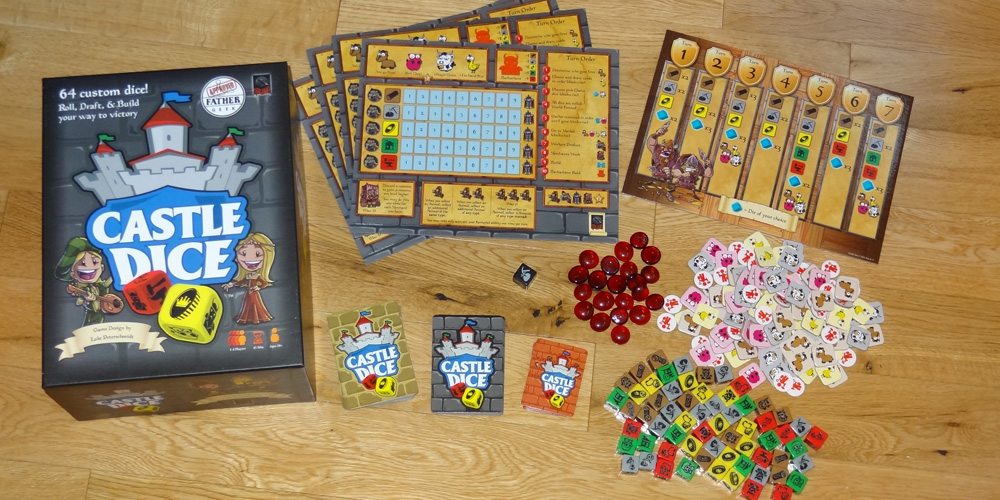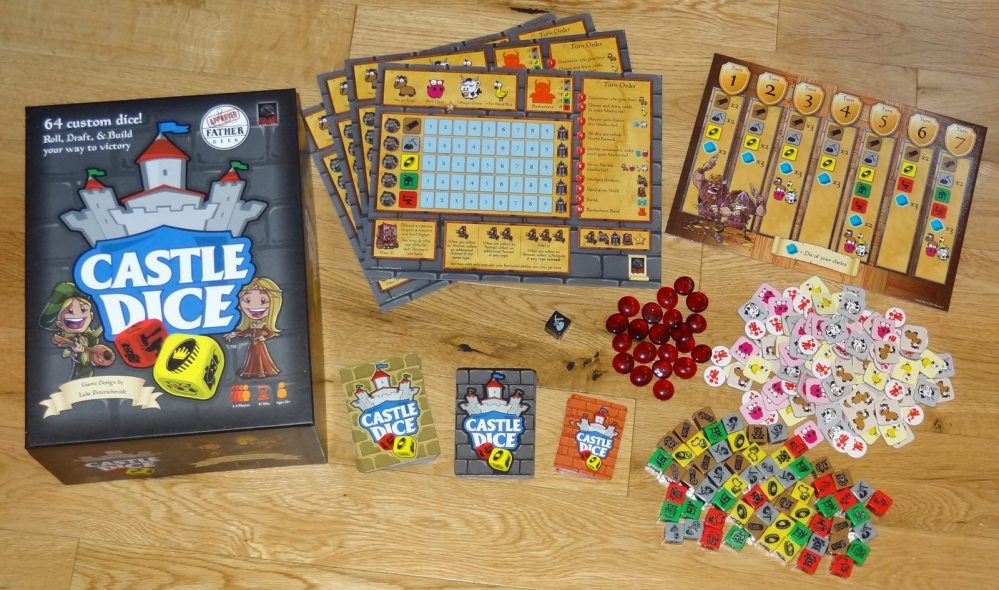
I first reviewed Castle Dice about a year ago, when it was on Kickstarter. The project funded successfully, and I’ve since received the copy I backed. Here’s a refresher on how the game plays and some reflections on the quality of the production version.
Overview: Castle Dice combines resource management, worker placement, and a whole lot of dice. You’re competing to build the best castle in seven rounds of play, but watch out for those barbarians! Fun fact: Castle Dice started as a design for a Minecraft board game competition, so resource gathering and building was inspired by that.
Players: 1 to 4 players
Ages: 10 and up (though some younger players could probably handle it)
Playing Time: 45 minutes
Retail: $65; or free print-and-play available if you have lots of dice.
Rating: A fun game with a mix of luck and strategy; not too complex to learn, despite the 10-step turn order.
Who Will Like It? If you like rolling big piles of dice, Castle Dice certainly has those in spades–a drafting mechanic mitigates the crazy luck factor. There’s still some luck in the draw of the cards, but if you like building stuff with resources then it’s worth checking out.
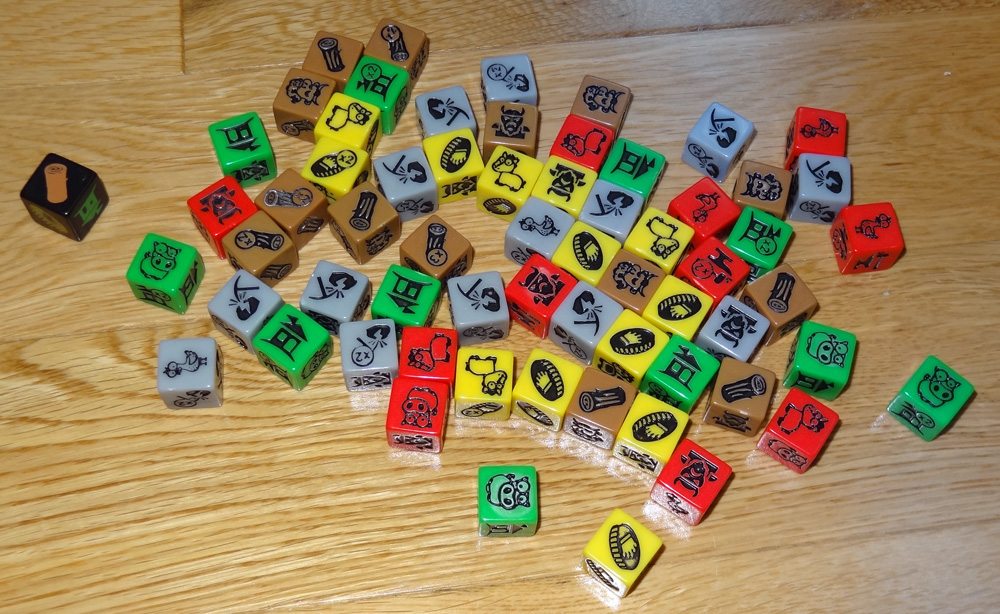
Theme:
Castle Dice uses a medieval theme: building castles, raising livestock, getting attacked by barbarians. Some of the mechanics fit the theme: guards protect you from losing resources; workers help produce more resources. But others aren’t as easily explained: having the most chickens increases your hand size. The Daughter gives you the “Pork Chop” ability, which lets you pick any face of a die. And the bonuses given for building various castle parts aren’t necessarily tied to the part, either.

Components:
The way the dice work is that each color is tied to a particular resource: brown dice have wood, grey dice have stone, yellow dice have gold, and so on. Each die also has one face that’s a Barbarian, and each die also has some number of animals. Wood, the most common resource, shows up a lot on the brown dice — you can even get two or three Wood on one die. But Iron is harder to get, so there are fewer faces showing iron (and more showing animals).
The game comes with:
- 63 dice
- 107 Cards: 42 Villager Cards, 47 Castle Cards, 18 Market Cards
- 4 Player Mats
- 1 Turn Tracker Mat
- 100 Animal Tokens (Horses, Pigs, Cows, Chickens)
- 60 Villager Tokens
- 21 Tracking Beads
- 1 Solo Play die
The Kickstarter page had mentioned the game being over 7 pounds, but apparently they were able to cut that down, because the current game is closer to 3.5 pounds.
The player mats have a lot of information on them, but for the most part are fairly easy to use. There’s a big section in the middle where you track how many of each resource you have. Villager tokens are used to mark if you have Workers, Guards, Merchants, and Farmers, each on their on section of the board. There’s also a space for animals, one for barbarians, and then a turn order summary on the right side.
The dice themselves are standard-sized six-sided dice, but they’re all custom. A nice touch is that they’re engraved, so the paint won’t rub off. My dice seemed to be pretty nice, though I did notice at least one that had a discolored face, and one that had a slight bulge on one face. The Solo Play die is a little larger, but the icons on that one are painted on rather than engraved–I suppose there’s a chance that will wear over time, but unless you’re primarily playing solo you won’t use it as much.
The Village and Castle cards are all standard sized, and the Market cards are half-sized. The icons are pretty easy to read, showing how many of each type of resource you’ll need to spend to build things, or with text showing how various special characters function.

My only complaint, really, is the box. You know me–I’m just picky about boxes. In this case, there are some things they did pretty well: the divider, as you can see, has nice slots for all the cards, a section for the dice, and wells for the animal and villager tokens and glass beads. There’s also one extra well for some unknown reason.
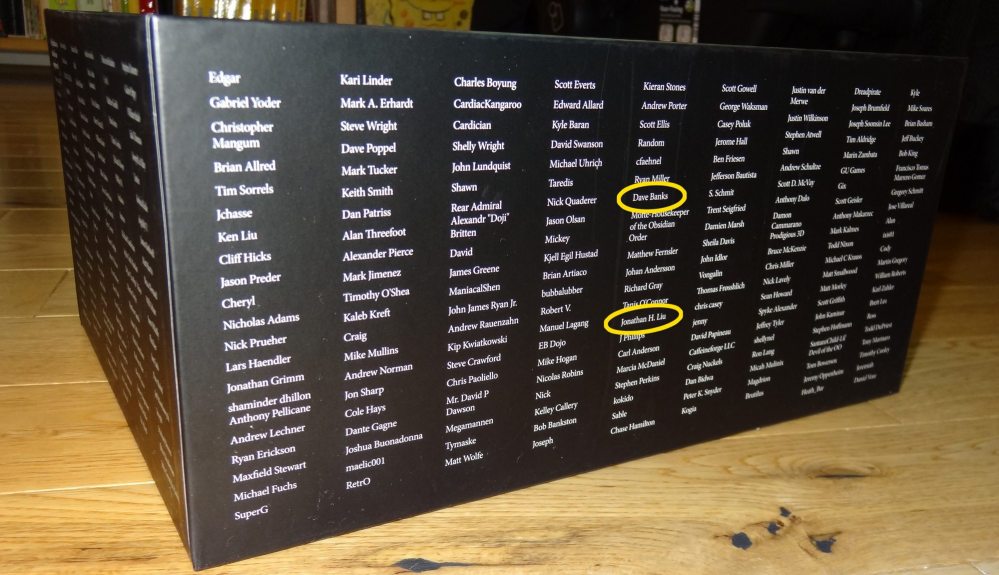
What bugs me is that the box is about 2″ deeper than it needs to be. That’s completely empty space underneath the divider, and it makes the exterior box enormous. I wondered at first whether it was so they could fit all their backer names on the box or if it was for shelf facing at a store. But when I asked the guys at Fun to 11 (I seem them occasionally at a local gaming group), the primary reason was because the box now fits exactly in a Priority Mail flat rate box.
Yep. It was slightly too large to fit in the flatter version, so they went for the next size up. I can understand that this probably cut down on shipping time and maybe costs for packing materials for fulfilling the Kickstarter rewards, but to me that seems like a poor long-term solution, because now the box just takes up much more space on my shelves than I’d like, and there’s not much I can do about it.
Gameplay:
The full rules are available here, if you want to read them for yourself.
The goal of the game is to build the best castle in seven rounds — as determined by victory points. You can also get victory points for having the most animals or villagers or with the Bard market cards, but most of the points will come through castle sections.
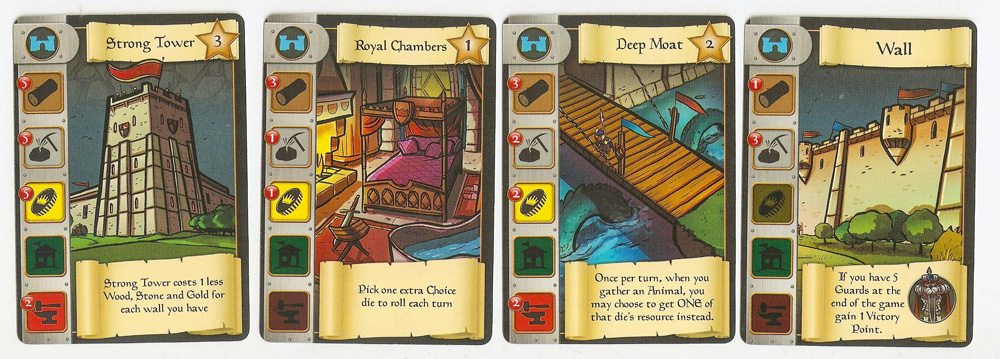
Everyone gets a player mat and starts with their tracker beads on “zero” for each resource: Wood, Stone, Gold, Land, and Iron.
Each round, players will get to draw cards until they have five in hand. You can discard any number of cards before drawing, but then you must choose how many you’ll draw from the Castle deck and how many from the Villager deck before looking at the new cards you’ve drawn. The Castle deck has all the various parts of the castle to build, but also has some people who can give you special one-time-use abilities. The Villager deck is where you’ll get various Villagers like the Miners, Merchants, Guards, and Farmers (plus some other folks who have their own special effects).

In each round, every player will roll some predetermined set of dice as shown on the turn tracker mat (e.g., in Round One you roll 2 brown, 2 grey, and 1 gold). In addition, you’ll get to choose two or three extra dice to roll. Once everyone has chosen their extra dice, all the dice are rolled. Any Barbarians you roll go onto your player mat in the Barbarians area; all the other dice (showing animals and resources) are placed in the World Pool in the center of the table.
Starting with the first player, each player picks one die from the pool and returns it to the supply. If it’s an animal, you get the corresponding animal token and place it on your mat. If it’s a resource, you move the appropriate tracker. Players take turns gathering until there are no more dice left.

You can then “go to market” by trading in one of each animal for a Market card. Most of these give various bonuses during the gathering phase, but there’s a Volunteer that counts as a Wall, and a Bard that is worth 1 point at the end of the game. On rounds 3, 5, and 7, it’s a mandatory holiday and you must trade in full sets of animals. (Note: in the prototype version, this phase was called the Feast–you were slaughtering a set of animals for the feast. Fortunately the Fun to 11 guys agreed that “slaughtering” was a little off-putting, especially with the horses there, and changed the name.)
Next, the Workers work–each worker produces one resource of their type. (Workers must be recruited from top to bottom, so you’ll start with Wood, then Stone, and so on.) Then the Merchants work–each Merchant you have allows you to trade in one resource for the next step up: Wood becomes Stone, Stone becomes Gold, etc.
Then you get to build: you can build any card from your hand (Castle or Villager) if you have the resources to pay for it. Castle parts go next to your mat. Villager cards are discarded and you put a villager token in the appropriate place on your mat. Guards protect resources from being stolen, and Farmers give you an extra animal once per round when you gather animals.
Finally, the Barbarians raid. For each Barbarian you have on your player mat, you lose one of each resource that isn’t protected by a Guard. Then the round ends, the turn tracker is moved to the next turn, and the game continues until all seven rounds have been played.

There are a few other rules that come into play. For instance, most of the Castle parts will provide some sort of bonus. The Royal Chambers allow you to pick one extra die; the Deep Moat lets you take a resource instead of the animal shown on a die. Also, the animals themselves offer a bonus for the person who has the most of them. The player with the most horses gets to go first. The player with the most pigs can do a “Pork Chop” action (picking the face of a die when they gather); the player with the most cows can change a villager into a different type of villager; the player with the most chickens gets an extra card draw.
At the end of the game, the player with the most animals also gets an extra victory point, and the player with the most total workers also earns a bonus victory point. Whoever has the most points wins!
Solo Play
For a single-player game, you set it up as a two-player game, and get out the black Solo Play die, which is used to determine which dice the dummy player will roll into the world pool. The resource type with the most dice is marked as the dummy player’s “priority” resource. During gathering, the dummy player will take the priority resource if available; if none are available, then you use the Solo Play die to determine what is taken. The “Barn” face means an animal is taken.
Note: you really only track animals collected by the dummy player, but there are no cards or resources to really track–everything is just discarded. Any Market cards the dummy player collects reduce your score by 1 at the end of the game.
Basically you just play your turns as normal, and you compare your score to the chart. 13 points or more is an Epic Win, 5 or fewer points is a Major Loss, and in between are varying levels of winning and losing.
Conclusion:
For the most part, the game is the same as the prototype version I played while the Kickstarter was still running, with just a few minor tweaks here and there. Terminology was changed–for instance, “Miners” became “Workers” which makes more sense when you’re talking about wood, or land. The “Feast” became “Market” and references to slaughtering animals was removed. The one thing that remained that still doesn’t make much sense to me is “Pork Chop!” On the player mat, for all the other animals it just says the effect: starting player, villager choice, +1 hand size. But for the pig, the effect is “Pork Chop!”
Castle Dice is a lot of fun: getting to roll handfuls of dice is always a blast, but I also really liked the dice drafting mechanic. If you roll a bunch of barbarians, you’ve had some pretty bad luck, but otherwise everyone’s dice are all in a big pool. Then you actually get some strategy because you have to decide which resources to take from this limited supply, and you have to guess what your opponents will want so they don’t snatch it away from you. That part reminds me a little of Take It or Leave It — a little bit of press-your-luck in which dice you leave for your opponents. In addition, the ability to add a couple of dice of your choice adds to the strategy: if you know you’ll need a lot of gold for what you’re building, then you better add yellow dice in case some of them don’t come up with gold.
The game is sort of a mix between Euro-style games and American games, because you get the drafting and resource management, but you also get a little bit of “take that” as well. There are cards that let you send your barbarians to another player, or steal animals from everyone. That can get pretty aggressive, although those are mostly in the Market cards which can be harder to get if you’re also building a lot.
Castle Dice is a pretty good mix of luck and strategy. The cartoony artwork keeps the tone light-hearted although you can play cutthroat if you really wanted to. The hardest part to plan for is the card draws. There are Walls which can reduce the cost of various other Castle parts, but they only award points if you have the right types of Villagers–and since those are also a random draw, there’s no guarantee that you’ll be able to build those Villagers even if you have enough resources. The Market cards can also be a mixed blessing, particularly on the last round: the Bard is the only card that’s worth anything on the last round, but you’re required to go to market if you can, so for most players it just means losing four animals for no benefit.
Overall, it’s a great idea and not exactly like anything I’ve played before. I’m not sure if this hits a full 11 on the fun meter for me, but it’s still pretty high. I liked it enough to back for a copy, but I admit that the $65 price tag still seems a bit high for the type of game this is–probably most of that cost is going toward those custom dice.
